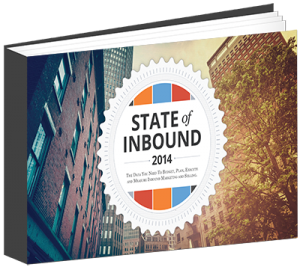 The fifth annual State of Inbound report was been released by HubSpot, and again, thousands of marketers from around the world report that inbound marketing is very effective for their companies. In fact, companies are increasing investments in inbound and they’re experiencing positive ROI from those initiatives.
The fifth annual State of Inbound report was been released by HubSpot, and again, thousands of marketers from around the world report that inbound marketing is very effective for their companies. In fact, companies are increasing investments in inbound and they’re experiencing positive ROI from those initiatives.
Marketers report that in 2014, blogging has the most significant impact on performance. Respondents who have prioritized blogging are 13-times more likely to achieve positive ROI than marketers who have not prioritized it. Behind blogging, the top inbound marketing projects are SEO/organic search, content distribution/amplification, long-form/visual content creation, webinars, interactive content creation, online tools, product how-to videos, and premium trials.
Overall, inbound tactics have increased with 85% of marketers using inbound in 2014 while only 60% used it in 2013. In total, half of the marketers who responded to HubSpot’s survey in B2B, B2C, and nonprofit sectors ranked inbound as their number one lead source. However, inbound success does not come without overcoming some challenges. Marketers identified the following top marketing challenges in 2014:
- Proving the ROI of marketing activities
- Securing enough budget
- Managing websites
- Targeting content for an international audience
- Hiring top talent
- Training the team
- Finding an executive sponsor
Interestingly, six of the above challenges could be linked directly to manpower resources:
- Proving the ROI of marketing activities requires someone with the knowledge and ability to collect the right data, crunch the numbers, and interpret them correctly.
- Securing enough budget requires having money to pay the team that will create, publish, design, and share the content.
- Managing websites requires having people on hand who can make the necessary edits to keep the content flowing.
- Targeting content for an international audience requires team members who understand international markets and can manage the translation and publishing process on a daily basis.
- Hiring top talent represents a direct investment in manpower resources.
- Training the team requires investing in ensuring your team has the right knowledge and skills to maximize the ROI of your marketing efforts.
Bottom-line, a successful inbound marketing strategy requires budget, but to overcome inbound challenges, a significant amount of budget must be invested in the right manpower to support and execute the strategy.
For large companies with more than 1,000 employees, the top marketing priorities in 2014 are increasing the number of contacts/leads and converting those contacts/leads into customers. Not far behind on the priority list are proving the ROI of marketing activities, reaching relevant audiences, and increasing revenue derived from existing customers. Farther down on the priority list is reducing the cost of contacts/leads/customer acquisition.
It’s interesting to see that large companies are very focused on increasing leads and turning leads into customers but they’re less concerned with proving the ROI of the marketing tactics they use to get those leads or reducing the costs to get those leads ($27/inbound lead and $45/outbound lead for companies with more than 1,000 employees). According to the survey respondents (from both large and small companies), only 53% are measuring ROI. The report authors explain:
Marketers that measure inbound ROI are 17 times more likely to see the same or greater ROI over the previous year. It’s likely that selection bias is impacting the data. After all, higher performing marketers are more likely to measure results, thus they are more likely to drive growth. Nevertheless, there’s a strong correlation between simply measuring ROI and achieving it. Marketers that are not currently measuring ROI should begin immediately.
You can follow the link at the beginning of the article to download the complete 54-page report and 42 charts from HubSpot (contact information required for download).
Image: HubSpot
Susan Gunelius is the author of 10 marketing, social media, branding, copywriting, and technology books, and she is President & CEO of KeySplash Creative, Inc., a marketing communications company. She also owns Women on Business, an award-wining blog for business women. She is a featured columnist for Entrepreneur.com and Forbes.com, and her marketing-related articles have appeared on websites such as MSNBC.com, BusinessWeek.com, TodayShow.com, and more.
She has over 20 years of experience in the marketing field having spent the first decade of her career directing marketing programs for some of the largest companies in the world, including divisions of AT&T and HSBC. Today, her clients include large and small companies around the world and household brands like Citigroup, Cox Communications, Intuit, and more. Susan is frequently interviewed about marketing and branding by television, radio, print, and online media organizations, and she speaks about these topics at events around the world. You can connect with her on Twitter, Facebook, LinkedIn, or Google+.


